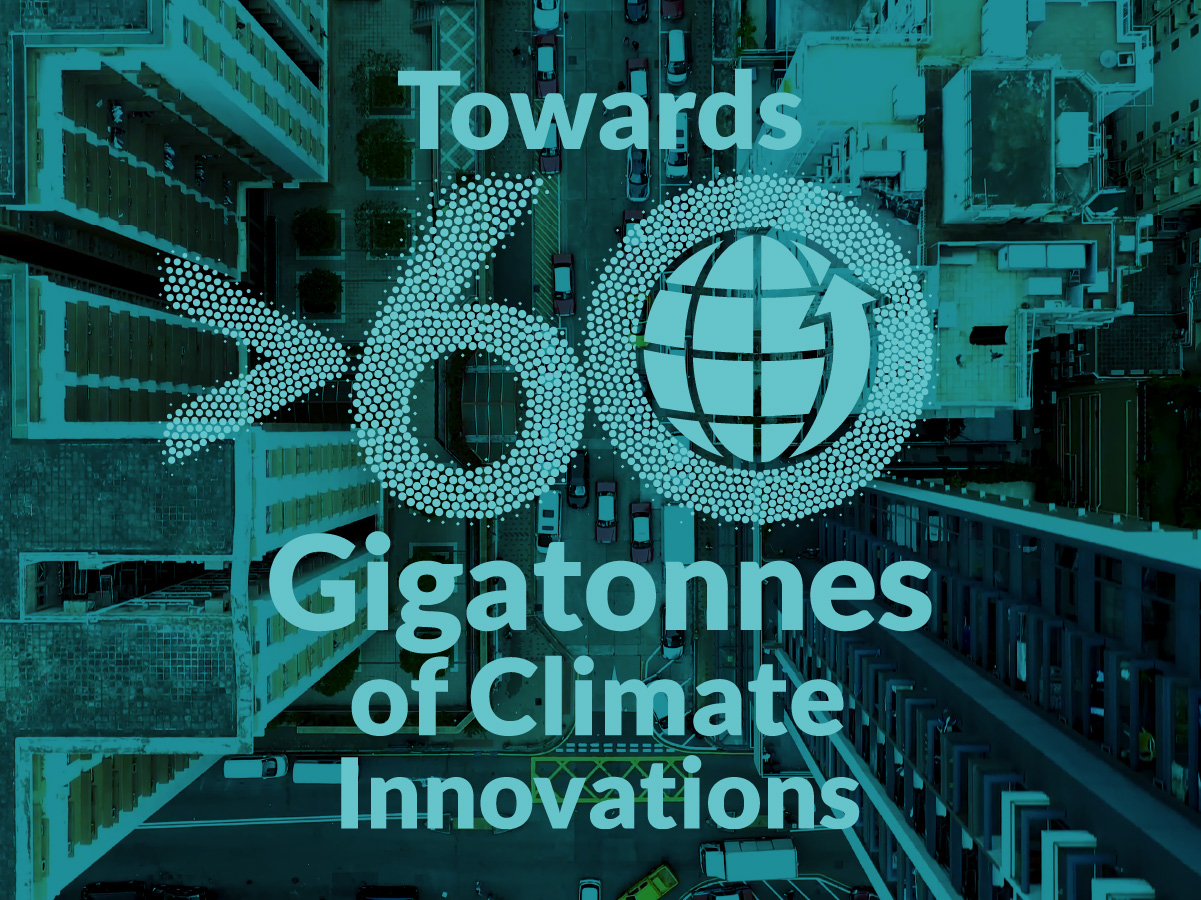Nominated innovations
1000 innovative clean energy solutions and > 150 framework enablers with the potential to deliver more than twelve gigatonnes of avoided emissions by 2030
These assessments are based on a basic avoided emission assessment. The overall concept of avoided emissions is that a solution (product or service) enables the same function to be performed with significantly less GHG emissions. The method of measuring avoided emissions, is to compare a baseline scenario without the enabling solution, with a scenario using the enabling solution; whereby the baseline represents the ‘business as usual’ (BAU) scenario.
These assessments are based on the framework document: The Avoided Emissions Framework (AEF) from September 2020

Harmony
Harmony wrote: Indians refer to our planet as' mother earth'. In the olden times our homes were built and resided in with complete harmony between their inhabitants and nature. In our daily lives we adopted materials and methods that were in sync with nature like cooking in earthen pots, using the twigs of the neem tree to clean our teeth, dyeing clothes with natural dyes etc. With industrialisation, urbanisation and resulting environmental degradation, urban life has lost this age old connect and our relationship with nature has become more of take than harmony... Source: EIT Climate KIC's ClimateLaunchPad
India

Harmony
Harmony
Harmony wrote: Indians refer to our planet as' mother earth'. In the olden times our homes were built and resided in with complete harmony between their inhabitants and nature. In our daily lives we adopted materials and methods that were in sync with nature like cooking in earthen pots, using the twigs of the neem tree to clean our teeth, dyeing clothes with natural dyes etc. With industrialisation, urbanisation and resulting environmental degradation, urban life has lost this age old connect and our relationship with nature has become more of take than harmony... Source: EIT Climate KIC's ClimateLaunchPad
Currently unavailable

Greenpeat organice resource
HBI S.r.l wrote: Hbi s. R. L. Exploits the hydrothermal conversion (htc) technology, to directly convert wet. Biodegradable waste in greenpeat. Greenpeat is a carbonaceous material, that can be used. For renewable energy production, or as soil improver: greenpeat increases the productivity of the land by 30%, reducing the need of water and of fertilizes. In this way greenpeat could be a valid substitute of fossil carbon (normally used for the production of thermal and electrical energy) and of fossil peat. However hbi strength is also in the technology used to produce greenpeat. This treatment is extremely more efficient and clean, if compared to the common technologies applied to wet organic substrates, such as composting or anaerobic digestion... Source: EIT Climate KIC's ClimateLaunchPad
Italy

HBI S.r.l
Greenpeat organice resource
HBI S.r.l wrote: Hbi s. R. L. Exploits the hydrothermal conversion (htc) technology, to directly convert wet. Biodegradable waste in greenpeat. Greenpeat is a carbonaceous material, that can be used. For renewable energy production, or as soil improver: greenpeat increases the productivity of the land by 30%, reducing the need of water and of fertilizes. In this way greenpeat could be a valid substitute of fossil carbon (normally used for the production of thermal and electrical energy) and of fossil peat. However hbi strength is also in the technology used to produce greenpeat. This treatment is extremely more efficient and clean, if compared to the common technologies applied to wet organic substrates, such as composting or anaerobic digestion... Source: EIT Climate KIC's ClimateLaunchPad
Currently unavailable

Health-e-Move
Health-e-Move wrote: Traffic-emissions contribute to global warming and climate change. Many people want to cut their own emissions, but they wonder whether it is healthy to cycle and walk in a polluted environment instead. Health-e-move is an app that answers this question; it wants to convince you and me to switch to more sustainable modes of transport by giving personalized and scientifically sound advice on the benefits of active mobility... Source: EIT Climate KIC's ClimateLaunchPad
Belgium

Health-e-Move
Health-e-Move
Health-e-Move wrote: Traffic-emissions contribute to global warming and climate change. Many people want to cut their own emissions, but they wonder whether it is healthy to cycle and walk in a polluted environment instead. Health-e-move is an app that answers this question; it wants to convince you and me to switch to more sustainable modes of transport by giving personalized and scientifically sound advice on the benefits of active mobility... Source: EIT Climate KIC's ClimateLaunchPad
Currently unavailable

Unleashing vehicles with thermal Imaging
HeatGrade wrote: In 2007, google unleashed a fleet of cars with roofmounted cameras to provide street-level images of roads around the world. Now ysi spinout heatgrade is bringing similar "drive-by" innovations to energy efficiency in homes and businesses. Heatgrade deploys trucks and cars with thermal-imaging rooftop rigs that create heat maps of thousands of homes and buildings per hour, detecting fixable leaks in "building envelopes"—windows, doors, walls, and foundations—to help owners curb energy loss... Source: EIT Climate KIC's ClimateLaunchPad
India

HeatGrade
Unleashing vehicles with thermal Imaging
HeatGrade wrote: In 2007, google unleashed a fleet of cars with roofmounted cameras to provide street-level images of roads around the world. Now ysi spinout heatgrade is bringing similar "drive-by" innovations to energy efficiency in homes and businesses. Heatgrade deploys trucks and cars with thermal-imaging rooftop rigs that create heat maps of thousands of homes and buildings per hour, detecting fixable leaks in "building envelopes"—windows, doors, walls, and foundations—to help owners curb energy loss... Source: EIT Climate KIC's ClimateLaunchPad
Currently unavailable

Smart buildings heating
HeatMe wrote: Buildings are responsible for approximately 40% of energy consumption and 36% of co2 emissions in the eu, major part of it is energy requirements for heating. . Heatme is an innovative self-sustainable heat pump tech based building heating system. It uses external environment heat energy not only for building heating & hot water purposes, but also to power it self. . Like solar panels, heatme runs at no costs, and unlike solar panels, heatme runs even in cold weather and no sunny days. . On a global level, heatme will dramatically reduce the consumption of energy resources and the pollution that results from it... Source: EIT Climate KIC's ClimateLaunchPad
Latvia

HeatMe
Smart buildings heating
HeatMe wrote: Buildings are responsible for approximately 40% of energy consumption and 36% of co2 emissions in the eu, major part of it is energy requirements for heating. . Heatme is an innovative self-sustainable heat pump tech based building heating system. It uses external environment heat energy not only for building heating & hot water purposes, but also to power it self. . Like solar panels, heatme runs at no costs, and unlike solar panels, heatme runs even in cold weather and no sunny days. . On a global level, heatme will dramatically reduce the consumption of energy resources and the pollution that results from it... Source: EIT Climate KIC's ClimateLaunchPad
Currently unavailable

Cost-competitive solar heat though optimised lenses
Heliac’s solar collectors produce utility-scale heat at unsubsidized costs they claim is below that of fossil fuels anywhere in the world. By using inexpensive lenses that work like magnifying glasses, it can generate temperatures up to 400 °C. Heliac targets process heat markets responsible for 15% of the global demand. These markets include desalination, district heating and cooling, and heat for numerous other standard industrial processes. Heliac believes their solution is scalable enough to meet any potential demand today.
Denmark
≈100

Heliac
Cost-competitive solar heat though optimised lenses
Heliac’s solar collectors produce utility-scale heat at unsubsidized costs they claim is below that of fossil fuels anywhere in the world. By using inexpensive lenses that work like magnifying glasses, it can generate temperatures up to 400 °C. Heliac targets process heat markets responsible for 15% of the global demand. These markets include desalination, district heating and cooling, and heat for numerous other standard industrial processes. Heliac believes their solution is scalable enough to meet any potential demand today.
≈100Mt CO2e/year

Clean energy generation from solar power
HelioGen wrote: Our team, heliogen produces energy convertors which converts solar energy into electrical energy which can be stored and used for various purposes. Heliogen provides clean and green energy at free of cost and also it substitutes the regular use of wood and kerosene in refugee camps and unelectrified villages which inturn decreases a lot of co2... Source: EIT Climate KIC's ClimateLaunchPad
India

HelioGen
Clean energy generation from solar power
HelioGen wrote: Our team, heliogen produces energy convertors which converts solar energy into electrical energy which can be stored and used for various purposes. Heliogen provides clean and green energy at free of cost and also it substitutes the regular use of wood and kerosene in refugee camps and unelectrified villages which inturn decreases a lot of co2... Source: EIT Climate KIC's ClimateLaunchPad
Currently unavailable

Solar concentrated power systems
Heliopulse wrote: We make solar concentrated power systems for households. Our system has many benefits: . -it doesn’t overheat in summer, . -it works effectively in winter, . -it tracks the sun, . -it has a short pay-back period. And, what is most important,. - it is 2 times more efficient than any other solar collectors systems. We are the first, who made a concentrated solar power system for households and individual use... Source: EIT Climate KIC's ClimateLaunchPad
Ukraine

Heliopulse
Solar concentrated power systems
Heliopulse wrote: We make solar concentrated power systems for households. Our system has many benefits: . -it doesn’t overheat in summer, . -it works effectively in winter, . -it tracks the sun, . -it has a short pay-back period. And, what is most important,. - it is 2 times more efficient than any other solar collectors systems. We are the first, who made a concentrated solar power system for households and individual use... Source: EIT Climate KIC's ClimateLaunchPad
Currently unavailable

Take-away cup made out of hemp
HempCup wrote: Consumption of take-away packaging such as coffee cups is one of the biggest sources of waste. Currently take-away cups are made with plastics, which is non-degradable and non-recyclable. We aim to produce such one time used packaging out of ecological and easily recyclable material - hemp... Source: EIT Climate KIC's ClimateLaunchPad
Lithuania

HempCup
Take-away cup made out of hemp
HempCup wrote: Consumption of take-away packaging such as coffee cups is one of the biggest sources of waste. Currently take-away cups are made with plastics, which is non-degradable and non-recyclable. We aim to produce such one time used packaging out of ecological and easily recyclable material - hemp... Source: EIT Climate KIC's ClimateLaunchPad
Currently unavailable

Natural compost building material
Hempstatic wrote: 50% of global carbon emissions stem from heating, cooling and constructing buildings. Currently, there is only little awareness concerning this issue. Hempcrete is a natural composite building material. It consists of hemp shives (derived from the wooden inner core of industrial hemp stalks), lime-based binder and water. Our hempcrete block is a construction material that can be used to assemble walls, roofs and floors and can be adjusted to all types of buildings. More carbon dioxide is sequestered in a hempcrete wall than is used to build it. Thus, hempcrete blocks outperform zero-carbon materials and allow building carbon-negative structures... Source: EIT Climate KIC's ClimateLaunchPad
Austria

Hempstatic
Natural compost building material
Hempstatic wrote: 50% of global carbon emissions stem from heating, cooling and constructing buildings. Currently, there is only little awareness concerning this issue. Hempcrete is a natural composite building material. It consists of hemp shives (derived from the wooden inner core of industrial hemp stalks), lime-based binder and water. Our hempcrete block is a construction material that can be used to assemble walls, roofs and floors and can be adjusted to all types of buildings. More carbon dioxide is sequestered in a hempcrete wall than is used to build it. Thus, hempcrete blocks outperform zero-carbon materials and allow building carbon-negative structures... Source: EIT Climate KIC's ClimateLaunchPad
Currently unavailable